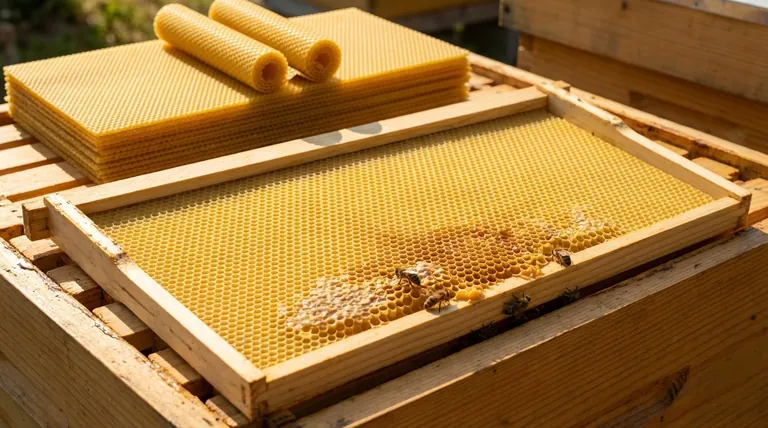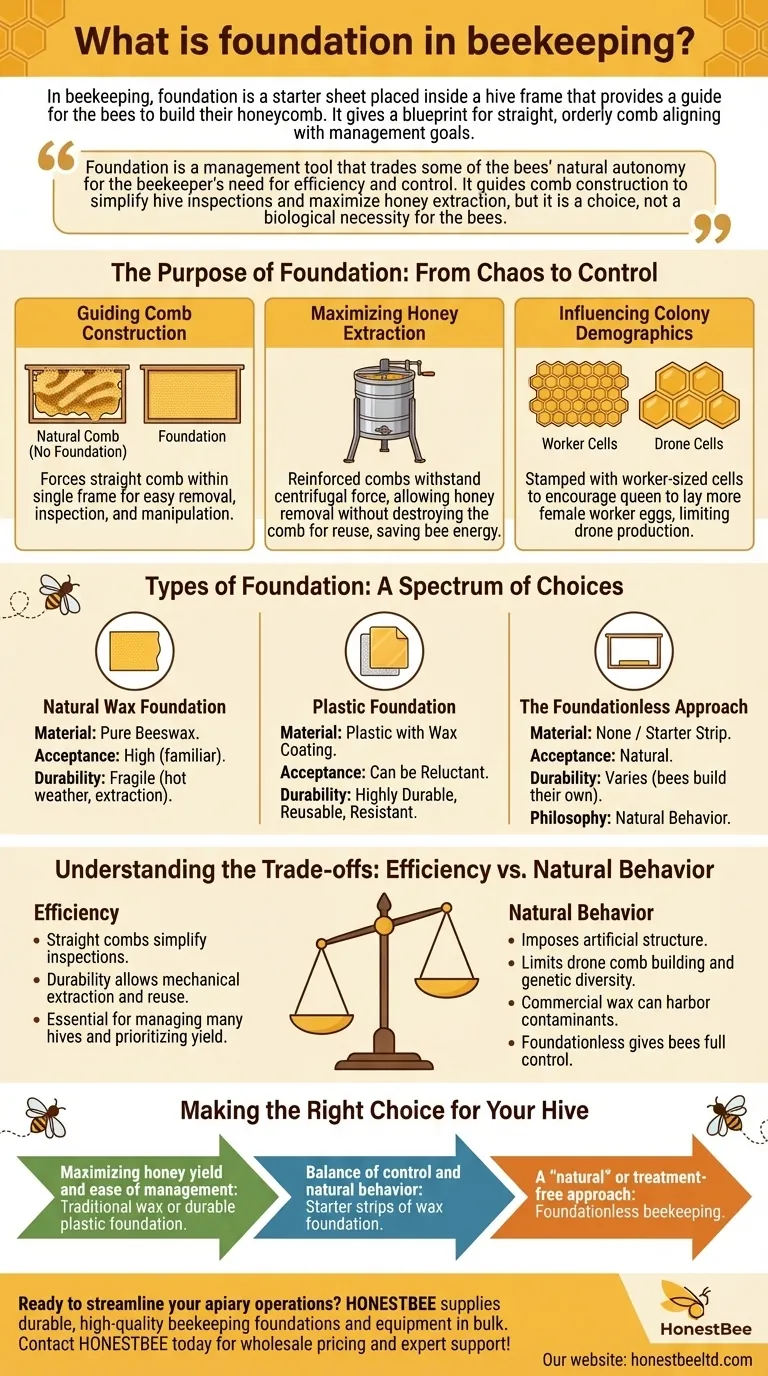In beekeeping, foundation is a starter sheet placed inside a hive frame that provides a guide for the bees to build their honeycomb. It is typically a thin sheet of pressed beeswax or a rigid piece of plastic imprinted with a hexagonal cell pattern. This gives the bees a blueprint, encouraging them to build straight, orderly comb that aligns with the beekeeper's management goals.
Foundation is a management tool that trades some of the bees' natural autonomy for the beekeeper's need for efficiency and control. It guides comb construction to simplify hive inspections and maximize honey extraction, but it is a choice, not a biological necessity for the bees.

The Purpose of Foundation: From Chaos to Control
Without guidance, bees will build comb according to their own instincts. While effective for the colony, this natural comb can be wavy, interconnected between frames, and difficult for a beekeeper to inspect without causing significant damage. Foundation solves this by imposing a predictable structure.
Guiding Comb Construction
Left to their own devices, bees often build "cross comb," which connects multiple frames together. This makes it nearly impossible to remove a single frame for inspection.
Foundation forces the bees to build straight comb within the confines of a single frame, allowing for easy removal, inspection, and manipulation of the hive.
Maximizing Honey Extraction
The straight, reinforced combs built on foundation are strong enough to withstand the force of a centrifugal honey extractor.
This allows the beekeeper to remove the honey without destroying the comb. The empty, intact comb can then be returned to the hive, saving the bees immense time and energy that would otherwise be spent rebuilding it from scratch.
Influencing Colony Demographics
Most commercially available foundation is stamped with a cell size specifically for worker bees.
By providing a template dominated by worker-sized cells, the beekeeper encourages the queen to lay more female worker eggs. This limits the amount of larger drone comb in the hive, focusing the colony's resources on foraging and brood-rearing rather than drone production.
Types of Foundation: A Spectrum of Choices
Beekeepers can choose from several types of foundation, each with its own characteristics.
Natural Wax Foundation
These are thin sheets made from pure, rendered beeswax. They are stamped with the standard hexagonal pattern.
Bees readily accept wax foundation, as it is a familiar material. However, it can be more fragile than plastic alternatives, especially in hot weather or during honey extraction.
Plastic Foundation
This is a rigid plastic sheet, often coated in a thin layer of beeswax to encourage bees to build on it.
Plastic foundation is extremely durable, reusable for many years, and resistant to damage from pests like wax moths. Some bees can be reluctant to draw comb on plastic, but its longevity makes it a popular choice.
The Foundationless Approach
Some beekeepers opt for foundationless beekeeping. Instead of a full sheet, they provide only a small starter strip of wax or a wooden guide along the top bar of the frame.
This method allows bees to build their own comb with natural cell sizes, including the drone comb they instinctively create. It is favored by those pursuing a more "natural" style of beekeeping.
Understanding the Trade-offs: Efficiency vs. Natural Behavior
The decision to use foundation is a central point in beekeeping philosophy. There is no single correct answer, only a series of trade-offs.
The Argument for Foundation
The benefits of using foundation are clear: efficiency, predictability, and ease of management.
Straight combs simplify inspections, and their durability allows for mechanical honey extraction and reuse. For anyone managing more than a few hives or prioritizing honey yield, foundation is considered an essential tool.
The Argument Against Foundation
Critics argue that foundation imposes an artificial structure on the colony. Forcing a uniform worker-cell size limits the bees' ability to build the drone comb they need for healthy genetic diversity.
Furthermore, commercial beeswax can potentially harbor contaminants from agricultural chemicals or in-hive treatments. The foundationless approach avoids these issues entirely, giving the bees full control over their own home.
Making the Right Choice for Your Hive
Your decision on whether and how to use foundation should be based on your specific goals as a beekeeper.
- If your primary focus is maximizing honey yield and ease of management: Traditional wax or durable plastic foundation is the most direct path to achieving this.
- If your primary focus is a "natural" or treatment-free approach: Consider foundationless beekeeping to allow bees to control their own comb construction and cell size.
- If you want a balance of control and natural behavior: Using starter strips of wax foundation can provide a guide without dictating the entire comb structure.
Ultimately, your choice of foundation is a defining decision in your beekeeping philosophy, balancing human convenience with the natural instincts of your bees.
Summary Table:
| Feature | Wax Foundation | Plastic Foundation | Foundationless |
|---|---|---|---|
| Material | Pure Beeswax | Plastic with Wax Coating | None / Starter Strip |
| Bee Acceptance | High | Can be Reluctant | Natural |
| Durability | Fragile | Highly Durable | Varies |
| Management Ease | High | High | Lower |
| Philosophy | Efficiency & Control | Efficiency & Longevity | Natural Behavior |
Ready to streamline your apiary operations? For commercial beekeepers and distributors, the right foundation is key to maximizing honey yield and hive health. HONESTBEE supplies durable, high-quality beekeeping foundations and equipment in bulk. Let us help you build a more productive and manageable operation. Contact HONESTBEE today for wholesale pricing and expert support!
Visual Guide

Related Products
- Beeswax Foundation Sheets Beehive Foundation for Wholesale
- Food Grade Plastic bee Foundation for Bee Frames
- Professional Frame Preparation: The HONESTBEE Electric Wire Embedder
- Manual Beeswax Comb Foundation Machine Wax Foundation Mill Embossing Machine
- HONESTBEE Professional Long Handled Hive Tool with Precision Cutting Blade
People Also Ask
- What are wax sheets made of? A Guide to Pure Beeswax Foundation for Healthy Hives
- What happens if foundation is given to colonies during a nectar dearth? Avoid Wasted Equipment and Stressed Bees
- How do beeswax foundations save bees time and energy? Boost Hive Productivity & Honey Yield
- How do you store beeswax foundation? Prevent Wax Moth Damage and Preserve Quality
- What is beeswax foundation used for? A Guide to Efficient Hive Management



















